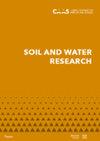Harmonisation of a large-scale historical database with the actual Czech soil classification system
IF 1.7
4区 农林科学
Q4 SOIL SCIENCE
引用次数: 4
Abstract
The possibility of the adequate use of data and maps from historical soil surveys depends, to a large measure, on their harmonisation. Legacy data originating from a large-scale national mapping campaign, “Systematic soil survey of agricultural soils in Czechoslovakia (SSS, 1961–1971)”, were harmonised and converted according to the actual system of soil classification and descriptions used in Czechia – the Czech taxonomic soil classification system (CTSCS). Applying the methods of taxonomic distance and quantitative analysis and reclassification of the selected soil properties, the conversion of two types of mapping soil units with different detailed soil information (General soil representative (GSR), and Basic soil representative (BSR)) to their counterparts in the CTSCS has been effectuated. The results proved the good potential of the used methods for the soil data harmonisation. The closeness of the concepts of the two classifications was shown when a number of soil classes had only one counterpart with a very low taxonomic distance. On the contrary, soils with variable soil properties were approximating several related units. The additional information on the soil skeleton content, texture, depth and parent material, available for the BSR units, showed the potential in the specification of some units, though the harmonisation of the soil texture turned out to problematic due to the different categorisation of soil particles. The validation of the results in the study region showed a good overall accuracy (75% for GSR, 76.1% for BSR) for both spatial soil units, when better performance has been observed in BSR. The conversion accuracy differed significantly in the individual soil units, and ranged from almost 100% in Fluvizems to 0% in Anthropozems. The extreme cases of a complete mis-classification can be attributed to inconsistencies originating in the historical database and maps. The study showed the potential of modern quantitative methods in the legacy data harmonisation and also the necessity of a critical approach to historical databases and maps.大规模历史数据库与实际捷克土壤分类系统的协调
能否充分利用来自历史土壤调查的数据和地图,在很大程度上取决于它们的协调。“捷克斯洛伐克农业土壤系统土壤调查(SSS, 1961-1971)”这一大规模国家测绘活动产生的遗留数据,根据捷克实际使用的土壤分类和描述系统——捷克土壤分类系统(CTSCS)进行了协调和转换。采用分类距离和定量分析的方法,对所选土壤性质进行再分类,实现了两类具有不同详细土壤信息的作图土壤单元(一般土壤代表(GSR)和基本土壤代表(BSR))在CTSCS中的转换。结果表明,所采用的方法在土壤数据协调方面具有良好的潜力。当许多土壤分类只有一个对应的分类距离很低时,两个分类概念的密切性得到了体现。相反,不同土壤性质的土壤近似于几个相关单位。BSR单元可获得的关于土壤骨架含量、质地、深度和母质的附加信息显示了某些单元规格的潜力,尽管由于土壤颗粒的不同分类,土壤质地的协调变成了问题。结果表明,两种空间土壤单元的总体精度均较好(GSR为75%,BSR为76.1%),其中BSR表现较好。不同土壤单元间的转换精度差异显著,从Fluvizems的近100%到Anthropozems的0%不等。完全错误分类的极端情况可归因于源自历史数据库和地图的不一致。该研究显示了现代定量方法在遗留数据协调方面的潜力,以及对历史数据库和地图采取关键方法的必要性。
本文章由计算机程序翻译,如有差异,请以英文原文为准。
求助全文
约1分钟内获得全文
求助全文
来源期刊

Soil and Water Research
Water resources, Soil Science, Agriculture-WATER RESOURCES
CiteScore
4.60
自引率
0.00%
发文量
26
审稿时长
>12 weeks
期刊介绍:
An international peer-reviewed journal published under the auspices of the Czech Academy of Agricultural Sciences and financed by the Ministry of Agriculture of the Czech Republic. Published since 2006.
Thematic: original papers, short communications and critical reviews from all fields of science and engineering related to soil and water and their interactions in natural and man-modified landscapes, with a particular focus on agricultural land use. The fields encompassed include, but are not limited to, the basic and applied soil science, soil hydrology, irrigation and drainage of lands, hydrology, management and revitalisation of small water streams and small water reservoirs, including fishponds, soil erosion research and control, drought and flood control, wetland restoration and protection, surface and ground water protection in therms of their quantity and quality.
 求助内容:
求助内容: 应助结果提醒方式:
应助结果提醒方式:


